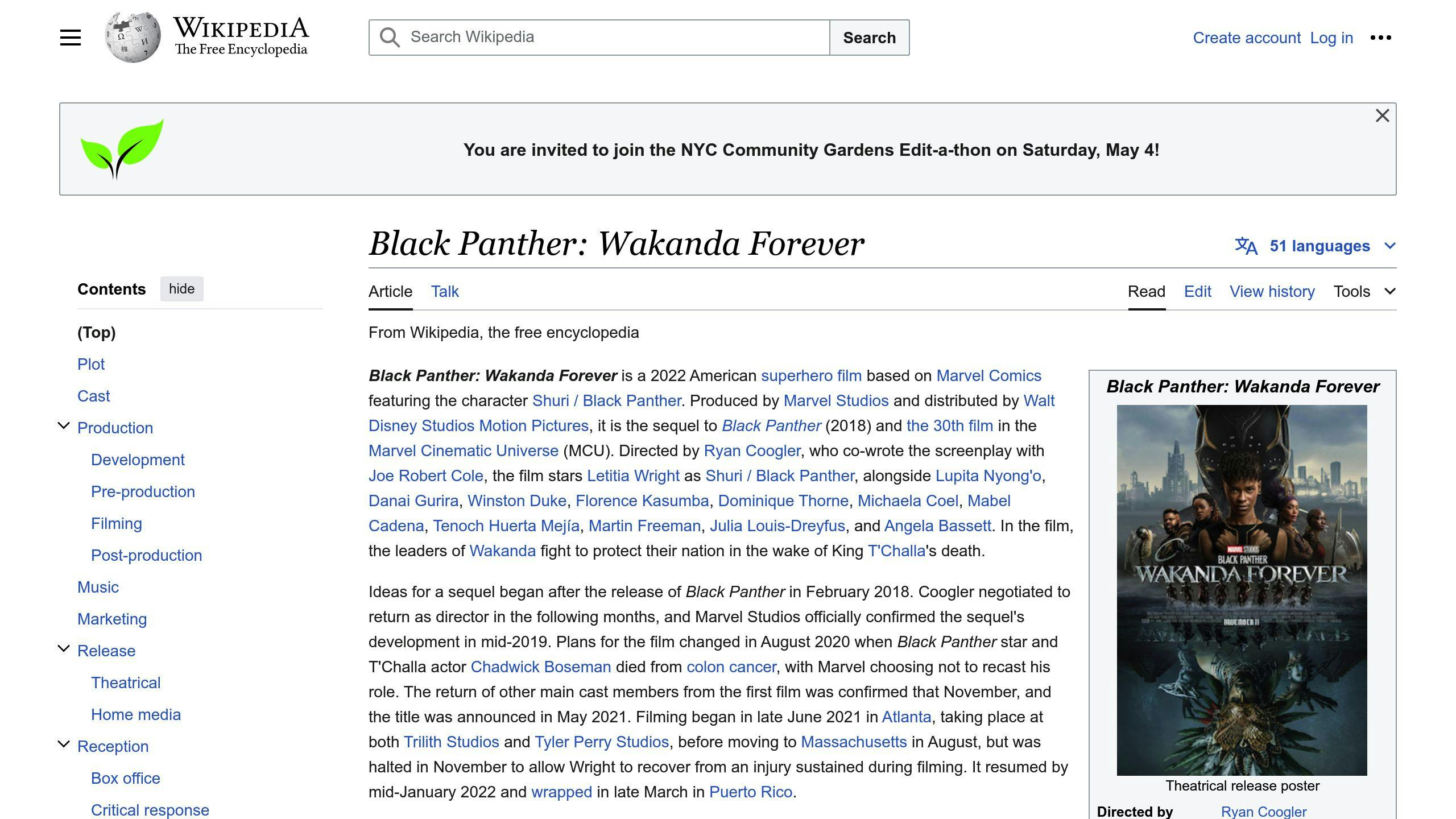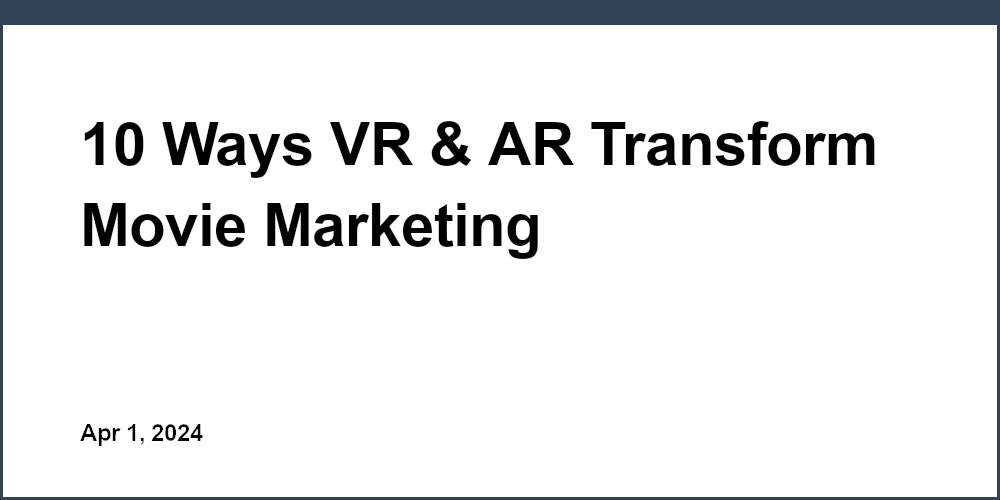A new study by National CineMedia (NCM) and Lumen Technologies found that cinema ads are far better at grabbing and holding viewers' attention compared to TV, streaming, and digital ads. The key findings:
-
Higher Attention Scores: Cinema ads had attention scores 4 to 7 times higher than TV, CTV, social media, and digital ads across various brands and categories.
-
More People Watching: 97% of viewers watched cinema ads, while only 38% watched TV ads and 35% watched CTV ads.
-
Longer Viewing Time: Viewers watched cinema ads for a much longer duration - 3 times longer than TV and CTV ads, and up to 10 times longer than social media ads.
The immersive, distraction-free cinema environment and captive audience make it easier for ads to capture and retain attention. Higher attention scores also directly correlated with better results like increased sales, brand recall, and app downloads.
Related video from YouTube
Key Benefits of Cinema Advertising
| Benefit | Description |
|---|---|
| Focused Audience | Moviegoers are focused on the big screen, making ads more noticeable. |
| Immersive Experience | The multi-sensory cinema environment enhances ad engagement. |
| Precise Targeting | Ads can be tailored to specific movie genres, ratings, and demographics. |
| Innovative Formats | Opportunities for interactive, AR, and VR ad experiences. |
| Measuring Engagement | Ability to measure and optimize for viewer engagement and ad effectiveness. |
As attention metrics gain importance, the study positions cinema advertising as a powerful platform for brands to effectively reach and engage audiences. Marketers should consider increasing cinema ad spend, especially for product launches, brand awareness, and targeting moviegoer groups.
What Are Attention Metrics?
Attention metrics measure how focused a person is on an ad. Unlike traditional metrics like impressions and views, attention metrics show the quality of engagement and how well a campaign works.
Measuring Attention
Attention metrics focus on time - specifically, how long someone views an ad and what they do during that time. Methods for measuring attention include:
- Eye-tracking: Recording where someone looks on the screen through lab or panel studies.
- Surveys: Asking questions about ad recall and purchase intent.
- Machine learning: Training algorithms to predict attention based on signals like viewability, dwell time, and scrolling.
Attention metrics range from loose measures like viewability to precise ones like eye-tracking. The goal is to understand if consumers are truly absorbing an ad's message.
Why Attention Matters
Several factors drive the need for attention metrics:
- Cookies going away: With third-party cookies becoming obsolete, advertisers need new performance indicators.
- Ad advancements: Attention metrics help determine which ad creatives have the greatest impact.
- Measurement needs: Brands want to show the link between awareness tactics and business outcomes.
As content competes for focus, attention has become valuable. By measuring attention, advertisers can better gauge an ad's true effectiveness and optimize campaigns.
Measuring Attention
| Method | Description |
|---|---|
| Eye-tracking | Recording where someone looks on the screen through lab or panel studies. |
| Surveys | Asking questions about ad recall and purchase intent. |
| Machine Learning | Training algorithms to predict attention based on signals like viewability, dwell time, and scrolling. |
Why Attention Matters
- Cookies Going Away: With third-party cookies becoming obsolete, advertisers need new performance indicators.
- Ad Advancements: Attention metrics help determine which ad creatives have the greatest impact.
- Measurement Needs: Brands want to show the link between awareness tactics and business outcomes.
NCM Study on 'Black Panther: Wakanda Forever'

National CineMedia (NCM) conducted a study to measure how much attention viewers paid to ads during the movie "Black Panther: Wakanda Forever" in Los Angeles. The study was done with Lumen and dentsu. Moviegoers were recruited to watch the film and see a mix of ads before the show.
Eye-Tracking Technology
Lumen's eye-tracking technology recorded where viewers looked on the screen. This data was used to calculate attention scores with machine learning models. The scores showed how engaged the audience was with the ads.
Focused Viewers
The cinema setting allows advertisers to reach viewers with few distractions. The study found that 97% of moviegoers watched the cinema ads, compared to only 38% for TV and 35% for CTV ads.
Longer Ad Viewing
Not only did more people watch the cinema ads, but they watched them for a much longer time. Viewers watched cinema ads three times longer than TV and CTV ads, and up to ten times longer than social media ads.
Better Brand Recall and Choice
Importantly, the study showed a direct link between attention scores and key advertising goals like brand recall and brand choice. Higher attention scores led to better ad performance, resulting in increased sales, foot traffic, and app downloads.
By using attention metrics, NCM aims to prove the effectiveness of cinema advertising to the marketplace, providing new insights and accountability for advertisers.
Attention Metrics Comparison
| Metric | Cinema Ads | TV Ads | CTV Ads | Social Media Ads |
|---|---|---|---|---|
| Viewers Watching Ads | 97% | 38% | 35% | - |
| Ad Viewing Duration | 3x longer than TV/CTV | - | - | Up to 10x shorter |
sbb-itb-b1b0647
Cinema Ads vs. TV, CTV, and Digital
The study shows that cinema ads perform much better than TV, Connected TV (CTV), and digital ads in grabbing viewers' attention. Here's how they compare:
| Metric | Cinema Ads | TV Ads | CTV Ads | Digital/Social Ads |
|---|---|---|---|---|
| Attention Score | 4-7x higher | - | - | - |
| Viewers Watching Ads | 97% | 38% | 35% | - |
| Ad Viewing Duration | 3x longer than TV/CTV | - | - | Up to 10x shorter |
Higher Attention Score: Cinema ads had attention scores four to seven times higher than TV, CTV, social, and digital ads across various brands and categories. This shows cinema's superior ability to capture and hold viewers' attention.
More Viewers Watching: Two and a half times more people watched cinema ads compared to TV and CTV - a remarkable 97% for cinema versus only 38% for TV and 35% for CTV. The immersive cinema setting ensures a highly engaged audience.
Longer Ad Viewing Time: People watched cinema ads for a much longer duration - three times longer than TV and CTV, and up to ten times longer than social media ads. This extended viewing allows for better ad comprehension and recall.
The findings clearly demonstrate cinema advertising's advantage in commanding viewer attention, a crucial factor for advertising effectiveness. As attention metrics gain importance, these insights position cinema as a powerful platform for brands to reach and engage their target audiences effectively.
Advertising Strategy Insights
The study's findings show that cinema ads are better at getting viewers' attention compared to TV, streaming, and digital ads. Here are some key points for marketers and cinema professionals:
1. Increase Cinema Ads in Media Plans
The results clearly show that cinema ads are great at grabbing and keeping viewers' attention. Marketers should consider spending more of their ad budgets on cinema campaigns, especially for product launches, brand awareness, or targeting specific moviegoer groups.
2. Use Cinema's Immersive Experience
Cinema ads work well because viewers are focused on the big screen with few distractions. Marketers can create visually striking and emotionally engaging ads that captivate audiences in this immersive environment. Storytelling and creative narratives can be very effective.
3. Combine Cinema with Other Channels
While cinema ads excel at getting attention, a well-rounded strategy should use a mix of channels. Marketers can use cinema ads as the main focus, supported by targeted digital, social, and TV ads to reinforce the message and reach more people. This multi-channel approach can maximize impact and overall campaign performance.
4. Measure Attention Metrics
As attention metrics become more important for measuring ad effectiveness, marketers should prioritize tracking and analyzing these metrics for their cinema ad campaigns. By monitoring attention scores, viewing duration, and viewer engagement, they can optimize their strategies and creative approaches for more impactful and memorable ads.
5. Explore Innovative Cinema Ad Formats
With new technologies, cinema advertising offers opportunities for innovation. Marketers can explore interactive, augmented reality (AR), or virtual reality (VR) ad experiences that further engage viewers and create lasting impressions. Working with cinema partners to develop and implement these cutting-edge formats can set brands apart from competitors.
6. Target Specific Audiences
Cinema advertising allows for precise targeting based on movie genres, ratings, and audience demographics. Marketers can tailor their ad content and messaging to resonate with specific target audiences, ensuring maximum relevance and impact.
By incorporating these insights into their advertising strategies, marketers and cinema professionals can take advantage of cinema advertising's ability to capture and retain viewer attention. As the industry evolves, staying ahead of trends and embracing innovation will be crucial for delivering effective and memorable advertising experiences.
Key Benefits of Cinema Advertising
| Benefit | Description |
|---|---|
| Captive Audience | Moviegoers are focused on the big screen, making it easier for ads to be noticed. |
| Immersive Experience | The multi-sensory cinema environment enhances ad engagement. |
| Precise Targeting | Ads can be tailored to specific movie genres, ratings, and audience demographics. |
| Innovative Formats | Opportunities for interactive, AR, and VR ad experiences. |
| Attention Metrics | Ability to measure and optimize for viewer engagement and ad effectiveness. |
The Future of Cinema Advertising
The NCM study shows that cinema ads are better at getting viewers' full attention compared to TV, streaming, and digital ads. As measuring viewer engagement becomes more important, cinema's immersive and distraction-free setting makes it a powerful channel for brands to leave a lasting impression.
Marketers should consider spending more of their ad budgets on cinema campaigns, especially for new product launches, building brand awareness, or targeting specific moviegoer groups. By using cinema's ability to engage audiences through visually striking and emotionally compelling storytelling, brands can create memorable experiences that boost brand recall and influence consumer behavior.
While cinema ads excel at grabbing and holding viewer attention, a well-rounded strategy should use a mix of channels. Marketers can use cinema as the main focus, supported by targeted digital, social, and TV ads to reinforce their message and reach more people. This multi-channel approach can maximize the impact and overall campaign performance.
As the industry evolves, exploring new cinema ad formats will be key. Brands can look into interactive, augmented reality (AR), or virtual reality (VR) ad experiences that further engage viewers and create lasting impressions. Working with cinema partners to develop and implement these cutting-edge formats can set brands apart from competitors.
Key Benefits of Cinema Advertising
| Benefit | Description |
|---|---|
| Focused Audience | Moviegoers are focused on the big screen, making it easier for ads to be noticed. |
| Immersive Experience | The multi-sensory cinema environment enhances ad engagement. |
| Precise Targeting | Ads can be tailored to specific movie genres, ratings, and audience demographics. |
| Innovative Formats | Opportunities for interactive, AR, and VR ad experiences. |
| Measuring Engagement | Ability to measure and optimize for viewer engagement and ad effectiveness. |
By incorporating these insights into their advertising strategies, marketers and cinema professionals can leverage cinema advertising's unique ability to capture and retain viewer attention. As the industry evolves, staying ahead of trends and embracing new formats will be crucial for delivering effective and memorable advertising experiences that resonate with audiences.
FAQs
Do cinema ads beat TV, streaming, and digital ads in grabbing viewers' attention?
Yes, the NCM study found that cinema ads are much better at capturing viewers' attention compared to TV, connected TV (CTV), social media, and digital ads:
-
Higher Attention Scores: Cinema ads had attention scores 4 to 7 times higher than all other video ad channels across various brands and categories.
-
More People Watching: 97% of viewers watched cinema ads, while only 38% watched TV ads and 35% watched CTV ads.
-
Longer Viewing Time: Viewers watched cinema ads for a longer duration - 3 times longer than TV and CTV ads, and up to 10 times longer than social media ads.
The study showed a direct link between higher attention scores and better results like improved brand recall, brand choice, sales, foot traffic, and app downloads. This proves that cinema advertising is highly effective in grabbing and holding viewers' attention.
What are the key trends in cinema advertising?
The main trends in cinema advertising involve using technology and data to deliver more targeted and engaging ad experiences:
| Trend | Description |
|---|---|
| Data-Driven Targeting | Using moviegoer data to show ads to relevant audiences. |
| Personalized Ads | Tailoring ad content based on viewer preferences and behaviors. |
| Immersive Formats | Interactive, augmented reality (AR), and virtual reality (VR) ad formats. |
| Attention Measurement | Measuring and optimizing ad effectiveness using attention metrics. |
| Multi-Channel Integration | Combining cinema ads with targeted digital, social, and TV campaigns. |
By adopting these trends, advertisers can ensure their cinema ads resonate with the right audiences and deliver memorable, engaging experiences that drive desired outcomes like sales and app downloads.


